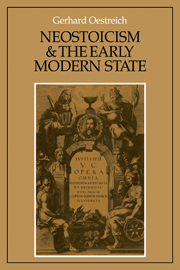Book contents
- Frontmatter
- Contents
- Foreword
- Introduction
- PART I JUSTUS LIPSIUS AND THE NETHERLANDS MOVEMENT
- PART II THE CONSTITUTIONAL DEVELOPMENT OF THE EARLY MODERN STATE
- 8 The religious covenant and the social contract
- 9 ‘Police’ and Prudentia civilis in the seventeenth century
- 10 From contractual monarchy to constitutionalism
- 11 The estates of Germany and the formation of the state
- 12 The constitutional situation of monarchy in Germany from the sixteenth to the eighteenth century
- 13 Army organization in the German territories from 1500 to 1800
- 14 The constitution of the Holy Roman Empire and the European state system 1648–1789
- 15 The structure of the absolute state
- Index
15 - The structure of the absolute state
Published online by Cambridge University Press: 04 May 2010
- Frontmatter
- Contents
- Foreword
- Introduction
- PART I JUSTUS LIPSIUS AND THE NETHERLANDS MOVEMENT
- PART II THE CONSTITUTIONAL DEVELOPMENT OF THE EARLY MODERN STATE
- 8 The religious covenant and the social contract
- 9 ‘Police’ and Prudentia civilis in the seventeenth century
- 10 From contractual monarchy to constitutionalism
- 11 The estates of Germany and the formation of the state
- 12 The constitutional situation of monarchy in Germany from the sixteenth to the eighteenth century
- 13 Army organization in the German territories from 1500 to 1800
- 14 The constitution of the Holy Roman Empire and the European state system 1648–1789
- 15 The structure of the absolute state
- Index
Summary
For over a hundred and fifty years European historical research has been exercised by the question of absolutism. The term may either be taken, as it customarily is, in its restricted sense, to refer to the period from the middle of the seventeenth century to the French Revolution – the age of absolutism proper – or, in the broad sense, as relating to that movement in the early modern period which saw the development of post-feudal absolute monarchy and gave the modern state its pre-revolutionary form. The term itself is a relatively late coinage, having arisen in liberal circles in the second and third quarters of the nineteenth century; in liberal constitutional and social thought it designated the undesirable aspects of unrestricted power wielded by a ruler. It has since entered most European languages, though it has not acquired everywhere the positive sense associated with the development of the modern state on the continent. The phenomenon is generally viewed unsympathetically in England, as the preference for the pejorative synonym ‘despotism’ indicates, though it is striking that the fifth volume of the New Cambridge Modern History, entitled ‘The Ascendancy of France’ (1961) and describing the great period of French absolutism, avoids the term ‘despotism’.
The term ‘absolutism’ may derive from the puissance absolue, the immense power and authority, enjoyed by the monarch, as it was interpreted in the history of political ideas, or it may come directly from the famous formulation of Jean Bodin, who in 1576 credited the prince with ‘summa in cives ac subditos legibusque soluta potestas’.
- Type
- Chapter
- Information
- Neostoicism and the Early Modern State , pp. 258 - 273Publisher: Cambridge University PressPrint publication year: 1982
- 1
- Cited by



